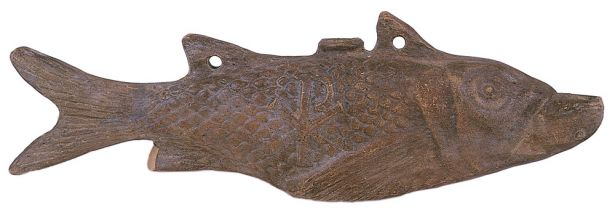Clay lamp in the form of a fish (00012)

Exhibition room: I.1 Old forms-New symbols
Date: 4th - 5th c.
Dimensions (cm): 8,2 Χ 22,5
The lamp is in the form of a fish carrying a smaller fish in its mouth. The mouth of the smaller fish is the opening through which the wick was introduced, while another opening in the middle of the back was intended for the oil, with which the lamp was filled and at the same time allowed ventilation. Two holes which perforate the back show that the lamp was hung up.
The fish is one of the earliest and most popular Christian symbols. It symbolized Christ himself, as the initial letters of the words Ιησούς Χρίστος Θεού Υιός Σωτήρ (Jesus Christ Son of God Saviour) spelt out ΙΧΘΥΣ (or 'fish' in Greek). The fish symbol was used by the first Christians especially in the catacombs and in funerary inscriptions as a symbol of salvation. The ChiRho and the cross have the same symbolic meaning and they decorate the body of the lamp on both sides.
This type of lamp in the shape of a fish is thought to come from Egypt and is found mainly in the 4th and 5th centuries. It is not known whether the lamps of this type, like other similar ones which imitate the forms of different objects or animals, had any special use. As means of illumination they can be found in domestic spaces, places of worship or burning next to a tomb. Wherever this particular lamp comes from, its symbolism is clearly loaded with many Christological symbols and it refers to the inotion of protection and salvation.








